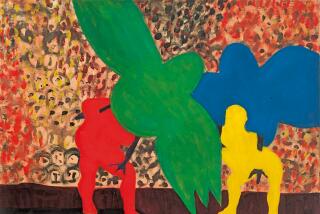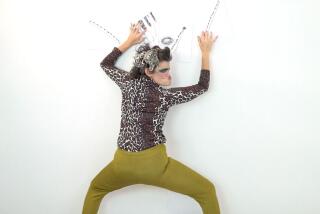Revival of the Hammer Dulcimer : Once-Forgotten Stringed Instrument Makes Comeback
Six years ago, Karen Williams had the kind of career many status-hungry young professionals would sacrifice a late-model BMW to get.
She was a young lawyer working long but well-paid hours at one of Los Angeles’ top entertainment law firms. Her future looked bright.
But within two years, she dumped the career for love.
The object of her devotion? A hammer dulcimer and the dream of life as an itinerant folk musician.
Williams, 30, of Manhattan Beach, is one of the local pioneers of a renaissance of the hammer dulcimer, a once-forgotten stringed folk instrument whose origins date back to 10th-Century Persia.
The instrument has been the subject of a slow revival across the United States for the last 10 to 15 years. In 1980, the revival touched Los Angeles and has been fast gaining momentum since.
Today this city, more often associated with electric rock ‘n’ roll than acoustic folk, has the incongruous distinction of being one of the nation’s hot spots for the hammer dulcimer. That status evolves from the effects of an annual festival dedicated to the dulcimer and a coterie of local players, such as Williams, who pop up with regularity at fairs, festivals, weddings, street corners and department stores.
Instantly Entranced
Williams, who grew up in Palos Verdes, heard the hammer dulcimer for the first time at the annual Renaissance Faire in Agoura when she was 13. “I was just instantly entranced,” she said.
Yet the instrument was rare then and it wasn’t until about seven years later, as an undergraduate in New England, that she heard it again. This time the musician was Bill Spence, a dulcimist from Upstate New York and one of the fathers of the hammer dulcimer’s revival.
In 1979 Williams was graduated from Loyola University Law School. Before she started her new law career, she decided to buy a hammer dulcimer.
Although there are dozens of dulcimer craftsmen today, many of them were just beginning their trade or worked in obscurity when Williams began looking for her first instrument.
She conducted her search on a cross-country car trip. In Colorado she found a make-it-yourself dulcimer kit, then returned to Los Angeles to start her law career.
Over the next few months, Williams worked on the kit with her father, as they had time. Then late one May night, she finished attaching and tuning the instrument’s last string, tapped out a few notes and was hooked.
In the fall of 1981 Williams teamed with another novice dulcimist, Carole Koenig. They discovered they could play four tunes together, and with Koenig leading a shy and uncertain Williams, the duo hurried over to Westwood, set up their instruments on a sidewalk and began playing. The pair earned $15 the first hour from passers-by, in part, Williams suspects, because the instrument was such a novelty.
“It really helps your confidence when people give you money just to hear you tune,” she said.
Before she built the dulcimer, Williams’ life and work revolved around words and communicating ideas with language, she said. Suddenly, with a dulcimer and another musician to play with, she found a new, more satisfying way to communicate. Being a lawyer seemed less important than being a musician.
Feeding Her Soul
Today Williams splits her time between work as a legal secretary, to pay the rent, and work as a hammer dulcimer teacher and musician--to feed her soul.
Sometimes her legal colleagues are dumbfounded to discover their secretary has a law degree. She has chosen to be a secretary because she needs a regular income to supplement a folk musician’s wages, but she doesn’t want to devote the time and energy that a career as a lawyer demands.
Pinpointing how many people in Southern California play the instrument is difficult because most are hobbyists who play for their own recreation at home. But Larry Hall, a Claremont engineer and dulcimist with the trio Nonesuch, estimates that there are at least 200 players in the area. Five years ago, there were no more than a handful, Williams said.
What is it about this instrument that has caused such interest? Most likely it is its unusual sound, which balances between ethereal and down-to-earth, nearly mimicking a blend of harp, banjo and mandolin.
Typically, a hammer dulcimer is made of polished wood, shaped like a trapezoid and about the size of a medium-size coffee table. Using carved wooden sticks or “hammers,” the musician taps 23 to 34 rows of wire strings that stretch taut across the length of the instrument. Each string makes a quick, solid noise that breaks into a long, dreamy undertone.
The hammer dulcimer bears little resemblance to the three-to-six-string lap or Appalachian dulcimer, although the two instruments are often confused. That dulcimer is plucked or strummed with fingers or a pick.
Elaine Weissman and her husband, Clark, founders of the nonprofit California Traditional Music Society in Tarzana, take some of the credit for the hammer dulcimer’s renaissance in Southern California.
“We knew that (the hammer dulcimer) was being ignored,” Elaine Weissman said. “We had a whole underground of friends who played lap and hammer dulcimers who wanted to connect with other players.”
To help them connect, the Weissmans organized a dulcimer festival in June, 1980, presented in association with the Beverly Hills Symphony.
That first year, the festival was a one-day event and attracted 400 people. Fewer than a dozen brought along hammer dulcimers.
This year, the fifth for the festival, the event lasted two days and included workshops and concerts in everything from dulcimer to ukulele. About 5,000 people attended, including about 200 hammer dulcimer players, some from as far away as Australia, Weissman said.
(The 1986 festival will be held June 21 and 22, with a free community dance the evening of June 20, at Cal State Northridge.)
Most hammer dulcimer players, including Williams, play traditional or folk music on the instrument. However, some players have started experimenting with other types of music and Williams and Ruskin have recently been working on an album that will include some non-traditional tunes.
Jay Round, a 28-year-old Wunderkind dulcimist based in Grandville, Mich., is one of the prime instigators to expand the instrument’s musical menu. Round has played the hammer dulcimer for 15 years and learned early tunes from Chet Parker, a veteran Michigan dulcimist.
A few years ago, Round recorded an album of ‘30s and ‘40s jazz standards. Initially the album was met with skepticism, particularly by traditionalists. However, “now I’m hearing more of this being done,” Round said.
It remains to be seen whether the hammer dulcimer’s revival will be long lasting. Yet players like Williams and Round seem determined to keep it from slipping into oblivion.
More to Read
The biggest entertainment stories
Get our big stories about Hollywood, film, television, music, arts, culture and more right in your inbox as soon as they publish.
You may occasionally receive promotional content from the Los Angeles Times.










